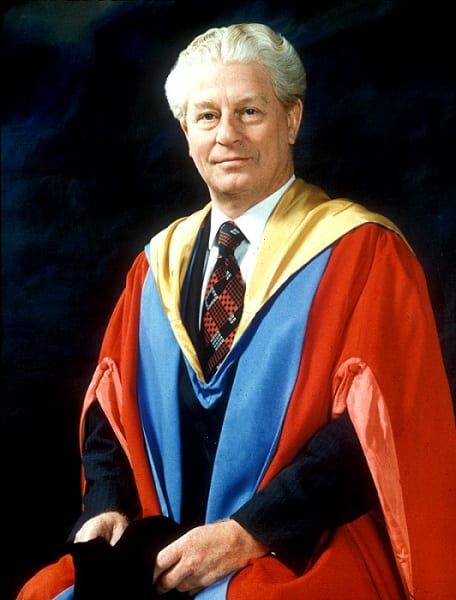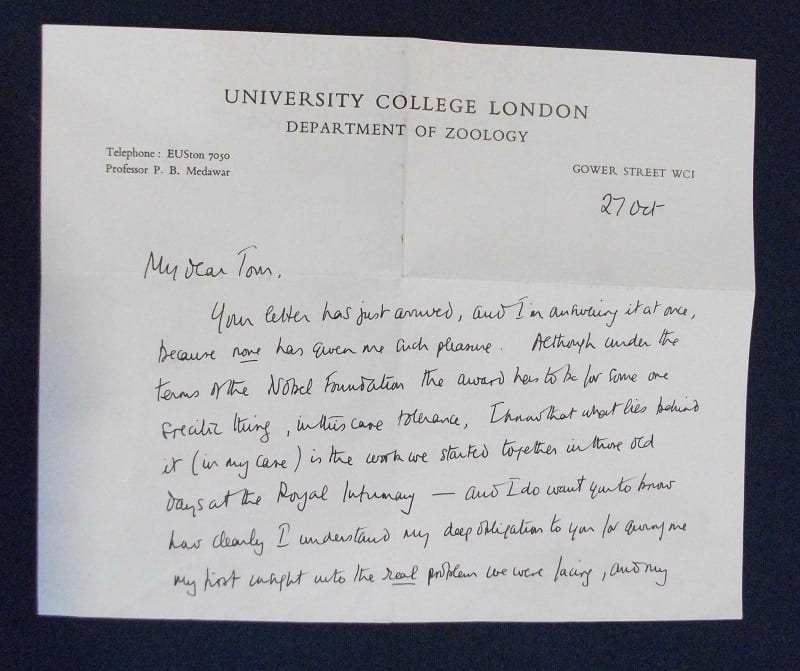24th November 2015 marks the centenary of the birth of Tom Gibson, President (1976-78) and Honorary Librarian (1964-74) of our College. He made an outstanding contribution to 20th Century medicine by developing a “hypothesis that laid the scientific foundation of tissue and organ transplantation”1.
Tom Gibson was born in Kilbarchan, Renfrewshire, on 24 November 1915. He was educated at Paisley Grammar School and Glasgow University where he graduated MB, ChB in 1938. He worked in the Medical Research Council Burns Unit, Glasgow Royal Infirmary, 1942-4. While at the Burns Unit he made an outstanding contribution to the understanding of the mechanism of homograft rejection. He was joined in Glasgow by Peter Medawar who had been working in Oxford on the same problem and their joint work “The fate of skin homografts in man”, was published in the Journal of Anatomy in 1943. The article is quoted in Morton’s Medical Bibliography as the work which placed the laws of transplantation on a firm scientific basis.
Medawar was knighted and awarded a Nobel Prize in Physiology or Medicine in 1960 (along with Frank Macfarlane Burnet) for the discovery of acquired immunological tolerance. However, Medawar was keen to acknowledge the debt he owed to Gibson, and in a letter to him states:
“I know what lies behind it (in my case) is the work we started together in the old days at the Royal Infirmary – and I do want you to know how clearly I understand my deep obligation to you for giving me my first insight into the real problem we were facing… Thank God I was lucky enough to team up with you!”
During this period Gibson also established the principles of management of the shock phase of burns. He subsequently worked in an RAMC maxillofacial surgery team until demobilisation in 1947. Following the war he joined the West of Scotland Plastic Surgery Unit, initially at Ballochmyle, later in Canniesburn Hospital, where he became Director in 1970 until he retired in 1980. His researches with Professor R.M. Kenedi culminated in the establishment of the Bioengineering Department of Strathclyde University, in respect of which he was appointed Visiting Professor and awarded an honorary DSc.
He published widely on tissue immunology, burns, bioengineering and various aspects of plastic surgery including its history. He was Honorary Librarian and a member of Council of the Royal College of Physicians and Surgeons of Glasgow from 1964 to 1974 and was President from 1976 to 1978. He wrote The Royal College of Physicians and Surgeons of Glasgow, A short history based on the portraits and other memorabilia, in 1983 when he was Honorary Curator of the College’s art collection.
The College archive houses a collection of Gibson’s case histories, publications, photographs and correspondence (RCPSG 55). You can see some of these items in our latest exhibition in Crush Hall which runs until the end of November 2015.
1. Conway H, Reid WH and Beaton JJ. Tom Gibson, plastic surgeon (1915-93): his life, the second set phenomenon, the host versus graft reaction, and the birth of tissue transplantation. Journal of Medical Biography; 2006, 14(4), p192-6.




I was operated on by Tom Gibson on 26th October 1959. The prognosis was doubtful. I have 2 children and 4 grandchildren and will forever be in his debt.
I was born in 1966 with a birthmark which had never been seen in this country before, and I was lucky to have been under Mr. Gibson’s care.
He first operated on me in the Western Infirmary when I was 6 weeks old .
To this day I cannot thank him enough for the countless operations and care that he showed me.
I always think that seeing the fabulous job he carried out at my final operation in Canniesburn, that had he been a young surgeon in today’s medical profession with all the technology they have to hand, that no surgeon in the world would be able to compete with his expertise.
Again I am truly grateful to him and all that he did ❤️
I was operated on in 1950, by Tom Gibson, at Ballochmyle Hospital, East Ayrshire. I had been born with spina-bifida myelomeningocele. He operated and in time, although I wasn’t expected to walk or have a productive life, I managed all of it, even having three children and now 3 grandchildren.
I never met him, but wished I had. I would have thanked him for his expertise, but mostly for my life. I owe him the life I’ve led, even though I’ve had many more surgeries in line with the problems that spina-bifida leaves one with.